|
< Earlier Kibitzing · PAGE 3 OF 3 ·
Later Kibitzing> |
| Aug-11-16 | | patzer2: If 22...Bxe6, my computer gives the win 23. Qxg6+ Qg7 (23... Bg7 24. Bxe6+ Rf7 25. Rxf7 Qxf7 26. Qxf7+ Kh7 27. Qf5+ Kh6 28. Bf7 b6 29. Qg6#) 24.
Bxe6+ Rf7 25. Bxf7+ Kf8 26. Rxf6 Qxg6 27. Bxg6+ Kg7 28. Rb6  (+8.92 @ 20 depth, Deep Fritz 15). (+8.92 @ 20 depth, Deep Fritz 15). |
|
| Aug-11-16 | | YouRang: Friday 22.?

click for larger view
This was easier than I expected for a Friday.
Black is already ahead in material, even if I (white) grab the Ng6. But my pieces are all active and attacking while black is lagging in development. I'm guessing that white had sacrificed some material to gain a tactic, and that tactic is what we are looking for. Taking the N with 22.Qxg6+ allows 22...Qg7, and I have to back off with Qh5 since (being behind in material), I can't afford to exchange queens. This gives black time to develop. The real tactic must involve that Pe6 which has a two-way pin. I can take it with the R or B, but my first guess is to take with the rook to maintain the bishop's pin on the king. So, <22.Rxe6>
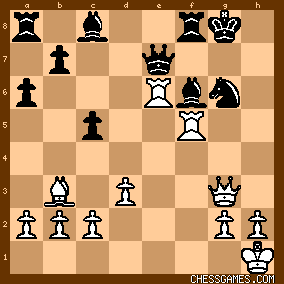
click for larger view
You don't have to consider this position for long to see that black is hopelessly overwhelmed. White is laden with attacking tactics, while black's uncoordinated "defenders" stand around like statues. - If 22...Bxe6 then 23.Qxg6+ and now 23...Qg7 fails to 24.Bxe6+ Rf7 25.Bxf7+ Kf8 26.Rxf6  (and 23...Bg7 24.Bxe6+ is even worse for black). (and 23...Bg7 24.Bxe6+ is even worse for black). - If 22...Qg7 then 23.Re7+ will win the Q (e.g. 23...Rf7 24.Rxf7 Qg6 25.Rf7xf6+ Kh7 26.Rf7+ Kh8 27.Rf8+ Kh7 28.R5f7+ Qg7 29.Rxg7+ ~#) |
|
| Aug-11-16 | | kevin86: White picks his opponent to pieces. |
|
| Aug-11-16 | | YouRang: <al wazir: Why is this game over? After 25. h4, threatening to win the ♘ with 26. h5, black must break the pin, for example, by playing 25...Kh7. Now if 26. Qc7+, then 26...Kh6. Now what?> After <25...Kh7 26.Qc7+ Kh6>
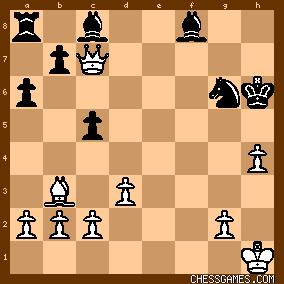
click for larger view
White has <27.Bg8> threatening Qh7# <27...Be7 28.h5!> attacking defender of Be7 <28...Kxh5 29.Bf7> pinning defender of Be7 <29...Kg5 30.Bxg6+ Kxg6 31.Qxe7> and the Q+2P vs R+B advantage should be winning. ~~~~~
Actually, the most fun continuation IMO is after <25...Kh7>

click for larger view
<27.Bg8+! Kxg8 28.Qxg6+ Kh8>
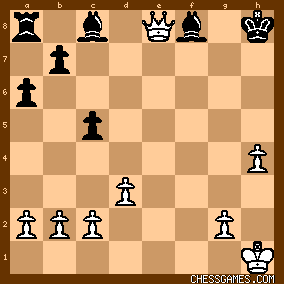
click for larger view
The lone queen has black paralyzed with pins!
If <28...Kg7> then <29.h5!>, and how does black stop the h-pawn without giving up Bf8? In fact, the longer black tries to save the bishop, the worse it gets, e.g. <29...Kg8 30.g4!> and black cannot stop the advancing pawns (and eventual mate) without surrendering big material. White just has to be careful against ...b5 and ...Bb7+ (with discovered attack on Q). :-) |
|
| Aug-11-16 | | saturn2: <YouRang Friday >ehm |
|
| Aug-11-16 | | YouRang: <saturn2> Oops. I guess that explains why today's Friday puzzle seemed more Thursdayish. :-) And I guess I had better show up for work tomorrow after all. :-( |
|
| Aug-11-16 | | saturn2: Discovering your slight error was my only satisfaction on CG today for I did not get the puzzle solution. Thanks for that. |
|
| Aug-11-16 | | David2009: Anand vs Gelfand 22? White is two pieces down but can winn one back immediately. Because it's a puzzle I spot the intermediary move
22.Rxe6 instead of the obvious recapture 22.Qxg6+. The main variation is
22...Bxe6 23.Qxg6+ Q or Bg7 24.Bxe6+ etc.
Before checking I decide to set the puzzle position

click for larger view
up in Crafty End Game Trainer:
http://www.chessvideos.tv/endgame-t... After 22.Rxe6 the prudent robot stays out of trouble with 22.Kh7! and
puts up a stiff resistance. I get to an ending of QPPP vs BNPP which I will have to gight hard to win. Enjoy doing better! Now it really is time to check:
= = = =
I se that <You Rang> has analysed similar variations to the Crafty defence: but in the variation 22.Rxe6 Kh7 23.Rxe7+ Bxe7 24.Rxf8+ Bxf8! 25.Bg8 Kxg8 26.Qxg6+ the robot defends with Bg7 27.Qe8+ Kh7 and threatens to unravel. I preferred to keep Bishops on the board. |
|
| Aug-11-16 | | YouRang: <David2009> I pretty much considered the loss of the queen to be enough to call it "solved", but in the case of <22.Rxe6 Kh7 23.Rxe7 Bxe7>
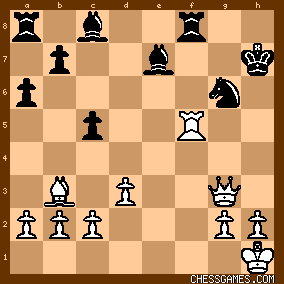
click for larger view
Rather than 24.Rxf4, my engine much prefers <24.Rf7+> Now, if 24...Rxf7, I have 25.Bxf7 with an immediate threat on the Ng6. It probably continues 25.Bf5 Qf3! threatening Bf5 and Qh5+ ...Kg7 Qxg6+ with mate to follow. Black's best is probably 24...Kh6 25.Rxf8 Bxf8 26.Qe3+ Kg7 27.Qe8 and white threatens to start pushing h4 (and ...Nxa4 loses to Qf7+ & Qxf8). |
|
| Aug-11-16 | | Patriot: Well...that was easy! 22...Kg7? lol Not much of a fight there! |
|
| Nov-23-17 | | Pasker: What a wholesale sacrifice game by Ananad!! |
|
| Nov-23-17 | | Sularus: wow! everything but the kitchen sink |
|
| Jul-25-19 | | jffun1958: recycled from Thur, 2016/08/11. |
|
| Jul-25-19 | | agb2002: Recycled. |
|
| Jul-25-19 | | gambitfan: 1) +5.30 (21 ply) 25.h4 ♗f5 26.♕f3 ♗e7 27.h5 ♖f8 28.hxg6 b5 29.♕b7 ♖e8 30.g4 ♗xg6 31.♔g2 ♔h6 32.♕xa6 ♔g5 33.♕xb5 ♔xg4 34.♗a4 ♖d8 35.♕c4+ ♔g5 36.♕e6 ♗f6 37.♕e3+ ♔h5 38.♗d7 ♖h8 39.♕f4 ♗xb2 |
|
| Jul-25-19 | | groog: agb2002, yes. However, it was worth it to see your analysis way back on Aug 11 16. |
|
| Jul-25-19 | | mel gibson: That's too hard -
I would never have seen that.
Stockfish 10 agrees with the text:
22. Rxe6
(22. Rxe6 (♖e1xe6 ♔g8-g7 ♖e6xe7+ ♗f6xe7
♖f5xf8 ♗e7xf8 h2-h4 ♗c8-f5 ♕g3-g5 ♗f8-e7 ♕g5xf5 ♗e7xh4 ♕f5-d7+ ♘g6-e7
♕d7xb7 ♖a8-h8 ♔h1-g1 a6-a5 ♕b7-c7 ♗h4-f6 ♕c7xc5 a5-a4 ♗b3xa4 ♖h8-h4 ♕c5-b5
♗f6-d4+ ♔g1-f1 ♖h4-f4+ ♔f1-e1 ♗d4-f6 ♔e1-e2 ♖f4-g4 ♔e2-f3 ♖g4-g5 ♕b5-b7
♖g5-f5+ ♔f3-e2 ♖f5-e5+ ♔e2-d1 ♖e5-f5 ♗a4-b3 ♔g7-h6 ♕b7-b6 ♔h6-g5 c2-c3
♖f5-f4 ♔d1-c2 ♘e7-f5 ♗b3-d5 ♖f4-f1 ♔c2-b3 ♖f1-f4 ♕b6-e6 ♔g5-g6) +7.55/37
99)
score for White +7.55 depth 37 |
|
| Jul-25-19 | | TheaN: I see that I haven't posted on this back in the day and also didn't recognize it. White is a wholesome <two> pieces down, so the direct 22.Qxg6+?, albeit logical, gives White no prospects after Qg7 (no loss either, though). If you see the concept if e6 were to be taken four times: 22/23.*xe6 24.Qxg6+ Bg7 (Kh8 25.Rh5#) 25.Qxe6+ Rf7 26.Qxf7+ Kh8 27.Rh5+ Bh6 28.Rxh6#, it's clear that e6 is the weak spot. <22.Rxe6!> is therefore White's only practical try. This threatens two discovered checks including one on the Black queen and the knight on g6 is still a sitting duck. As we've seen if the captures on e6 continue Black's mated, 22....Bxe6? seems wrong but not because of the immediate 23.Bxe6+: White follows 23.Qxg6+! first, and any defense fails because White can freely take on e6 afterwards: 23....Qg7 (Kh8 24.Rh5+ #2; Bg7 24.Bxe6+ +-) 24.Bxe6+ Rf7 (Kh8 25.Rh5+ #2) 25.Bxf7+ Kf8 26.Rxf6! forces a queen trade and a win, primarily 26....Qxg6 27.Bxg6+ Kg7 28.Rb6 +- where White has the luxury to take on b7 even with the bishop still en prise. Black's alternatives are few because of the joined threats of 23.Rxe7+, Rxf6+ and Qxg6+. In fact, only a king move helps to defuse the discovered check and taking on g6. 22....Kh8? runs out of any checks but fails after 23.Qxg6 +-. 22....Kf7? defends the queen but allows 23.Rexf6++ +-. 22....Kh7 is similar to the game line but slightly more logical is <22....Kg7> as it defends f6. I have to be honest I underestimated throwing the queen: after <23.Rxe7+ Bxe7> Black has a rook and two pieces for the queen and three pawns, so White has to push here before Black can regroup. Once you see it, its obvious the king and knight are still in a peculiar position so after <24.Rxf8! Bxf8 (Kxf8 25.Qxg6 +-) 25.h4! +-> can push the attack just in time. I haven't looked at this though as I thought Rxe7 won on the spot. Awesome combo by Anand. |
|
| Jul-25-19 | | mel gibson: <Awesome combo by Anand.> It sure was.
Guys like him are super human. |
|
| Jul-25-19 | | King.Arthur.Brazil: After the simple 22.♕xg6+ ♕g7 and there's noway to white continue the attack. If 22...♗g7, white could have the strong 23.♖xe6... Therefore, it is natural that this move come first... so, the wrong line gives the address to the right one. To answer 22.♖xe6! with ...♗xe6 would follow 23.♕xg6+ (23... ♔h8 24.♖h5#) 23...♕g7 24.♗xe6+ (...♔h8 24.♖h5+ and checkmate next) 23...♖f7 24.♗xf7+ ♔f8 25.♕xf6 ♕xf6 26.♖xf6 ♔e7 27.♖f3 ♖e8 28.♗d5 with easy win. If 22...♕xe6 23.♕xg6+ ♗g7 24.♗xe6+ ♗xe6 25.♕xe6+ (... ♖f7 26.♕xf7+ ♔h7 27.♖h5#) ... ♔h7 26.♖h5+ ♗h6 27.♖xh6+ ♔g7 28.♕g6#. Therefore, the text move is one last trial to survive. |
|
| Jul-25-19 | | King.Arthur.Brazil: Your simplification is very interesting <YouRang> but I saw a different way. Diagram: 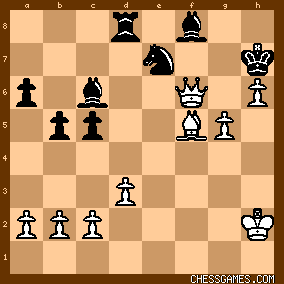
click for larger viewAfter 25.h4 ♔h7 (it seems forced) 26.h5 ♘e7 (forced too) 27.♕g5 b6 28.g4 ♗b7+ 29.♔h2 ♖d8 (♖e8 29.♗f7... helps the white) 30.♕f6 ♗c6 31.g5 b5 32.♕f7+ (...♗g7 33.h6 ♖g8 34.♕xd7 win more material) 32... ♔h8 33.♗e6 (...♗d5? 34.♕f6+ ♔h7 35.♗xd5 lose more material again) 33... ♖b8 34.h6 ♖d8. Now the beautiful does not solve: 35.h7 (...♖b8 36.♕g8+ ♘xg8 37.hxg8=♕#) ♗g7 36. ♕xe7 ♖f8 }. The win comes from 35.♕f6+ ♔h7 (only) 36. ♗f5+ Diagram. (♔g8 37.h7#) ♘xf5 37.♕xf5+ ♔g8 38.♕g6+ ♔h8 39.♕f6+ ♔g8 40.♕xd8. If black change the order of moves, with 33...♖a8 and 34...♖b8 the sequence is 37.♕xf5+ ♔g8 38. ♕e6+ ♔h8 39.♕e5+ ♔... 40.♕xb8. Also, if 33...♖b8 and 34.♖a8 the idea is the same 37.♕f5+ ♔g8 38.♕g6+ ♔h8 39.♕xc6. Now 39... ♖d8? lose directly with 40.♕f6+ ♔g8 41. ♕xd8 or 39...♖b8 40.♕f6+ (♔h7 41.♕f7+ ♔h8 42.g6 and checkmate next) 40... ♔g8 41.g6 ♖b7 42.h7+ win all black pieces. Finally, 39... ♖a7 the procedure is a little different 40. ♕e8! ♔g8 41.g6! ♖e7 42.h7+ ♔g7 43.h8=♕+ ♔xh8 44.♕xf8#. |
|
| Jul-25-19 | | schachfuchs: <King.Arthur.Brazil
After 25.h4 ♔h7 (it seems forced)>
26.Qf3 seems to be the most annoying. |
|
| Jul-25-19 | | PhilPlaysChess: I went with the obvious 21.QxN, which leaves white positionally superior and probably likely to win anyway. But of course, there was the dual oppotunity of checkmate and getting a peice with the actual move 21.Rxe6! Didnt see that :(
How many of you got the real solution first time? Be honest! |
|
| Jul-26-19 | | agb2002: <groog: agb2002, yes. However, it was worth it to see your analysis way back on Aug 11 16> Thank you! Miniatures like this, involving such players, can leave a deep impression. |
|
| Jul-26-19 | | King.Arthur.Brazil: Dear <Schachfuchs>, I went on this line initially too, but I gave up. After the following sequence:
27. ♕f3 ♗d7, 28. ♕xb7 ♗c6,
29. ♕c7 ♔h6, 30. ♗f7 ♖c8,
see the diagram.

click for larger viewThe lines:
a)31. ♕f4+ ♔h7 32.♗g6+ ♘xg6 33.♕f5 ♖c7 34.hxg6+ ♔g8 35.♕e6+ ♔h8 36.♕e5+ ♖g7 37.♕f6 ♗xg2+ 38.♔xg2 ♔g8 or
b)♕d6+ ♔g7 32.♕e6 ♖d8 33.♗g6+ ♘xg6 34.♕xc6 ♖d4...
the black will loose more material, but the check-mate come slow. My proposal is to win with by force with black almost paralised (giving him the least chance), to early find the check-mate. My initial line was: 27.♕f3 ♗d7, 28.♕f6 ♖d8, 29.c3 b5 30.♗c2 ♗f5 31.g4 ♗xg4 32.d4+ ♔h8 33.h6 ♗xh6 34.♕xh6 ♗f3+ 35.♔h2 ♗d5...wins but mate will last... Then I studied other lines. |
|
 |
 |
|
< Earlier Kibitzing · PAGE 3 OF 3 ·
Later Kibitzing> |





